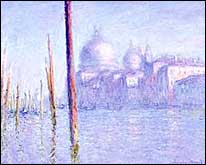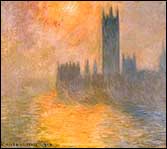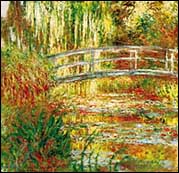 |
 |
 |
|
|||
|
As we grow up and keep hold of these impressions and many more besides, why is it we become more accustomed to them, and the world becomes less magical? Could that be the reason why we travel -- to search for new impressions?
An then there's this thing we call art -- which can convey a special kind of impression. Claude
Monet, one of the pioneers of a group of artists who became known as impressionists, spent
virtually his whole life searching for a way to distill into a painting, the magic inherent in a
moment of seeing. Join us for an impressionist's tour with Jim Metzner. Impressionist's Tour
Metzner: I'm at the waterfront of the Grand Canal near the church of San Georgio Majori in Venice; the very spot where Monet painted one of his incandescent views of this city. And although the ghost of what he saw still lingers here in resonance with his painting, there is always another impression hovering, waiting to be seen -- or heard. It's noon, and you can hear church bells ringing on both sides of the canal, and a boat -- a water taxi -- passing in between. And in your mind's ear, follow that furthest ball, and fly across the water to the Piazza da San Marco for another impression, one that Monet heard, but didn't paint.
San Marco is an enormous plaza, ringed with outdoor cafes, many of which have their own little
orchestras or jazz combos. There's a photograph of Monet as an older man, with his second wife,
Alice, feeding pigeons here. One of them is perched on his head. And indeed if you purchase a dollar's-worth bag of corn and hold it in your hand, you will in an instant, be literally covered with pigeons.
It's an odd sensation.
Picture a narrow street in Venice: some boys are playing soccer; nearby, a cat sits watching on a windowsill. Paul Tucker is a professor of Art History at the University of Massachusetts in Boston, and the author of several books on Monet's life and work. Tucker: "The world of vibration, visual phenomena and aesthetic contemplation are intimately related. Paintings project themselves off the wall through color, sound through waves of emotion. Monet wants us to be immersed in this world." "Monet built his own world...a place where wonder exists...where he could translate his ideas into paint..."
Metzner: Monet's world was centered around his estate in Giverny France, about forty miles from
Paris. It was here that he returned after his vacation in Italy. Monet designed and built a
series of gardens and ponds at Giverny, that were in themselves works of art. And they became
inspirations for whole series of his paintings. The Japanese bridge, the lily pads that floated
on the pond waters, were motifs that Monet returned to again and again: rediscovering their luminosity,
reinventing his craft. Today, Giverny has become a prime destination for tourists from all over the
world. And as they leave Monet's house and gardens, they must pass through a tunnel to reach the lily ponds,
leaving their own imprint on the soundscape.
If you go to the L'Orangerie Museum in Paris, to be in a room surrounded by Monet's water lily paintings, you'll notice that the room is shaped like a parabola, and if you stand at either of the room's focal points -- the gathering place for all the sound -- you will be immersed in both the visual panorama and also ripples and waves of sound coming at you from every direction. It's an impression to savor.
Tucker: "The lily pads are like sounds...poetry of translation... valuing the momentary:
the (impressions that become) imbedded in our memory."
Metzner: Before we die, we have this impulse to leave something of ourselves behind, as if to say
that we were here in part, not only to receive these impressions, but to make something of them, art
perhaps. Or, maybe that's the wrong way round. Maybe the impressions were supposed to make something
of us. Not so far from the L'Orangerie, the bells of Notre Dame are ringing, and every one who hears them knows what they are. But still, contained with this moment, this sound is something no thought, no word, can lay a finger on. So you record the bell, you paint a picture, but you can never really capture that essential, elusive magic. I wonder if that's what compelled Monet to paint the same motifs again and again. Perhaps there was something inside him that was still in question, still unfinished, like an empty canvas. From Paris, I'm Jim Metzner, for the Savvy Traveler.
|
 | American Public Media Home | Search | How to Listen ©2004 American Public Media | Terms of Use | Privacy Policy |




